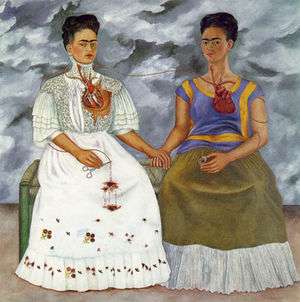The Two Fridas
| Spanish: Las dos Fridas | |
 | |
| Artist | Frida Kahlo |
|---|---|
| Year | 1939 |
| Medium | Oil on canvas |
| Movement | |
| Dimensions | 173.5 cm × 173 cm (68.3 in × 68 in) |
| Location | Museo de Arte Moderno, Mexico City |
The Two Fridas (Las dos Fridas in Spanish) is an oil painting by Mexican artist Frida Kahlo. The painting was the first large-scale work done by Kahlo and is considered one of her most notable paintings.[1] It is a double self-portrait, depicting two versions of Kahlo seated together. One is wearing a white European-style Victorian dress while the other is wearing a traditional Tehuana dress.[1] Some art historians have suggested that the two figures in the painting are a representation of Frida's dual heritage.[2] Her father, Guillermo Kahlo, was German; while her mother, Matilde Calderon, was a mix of Spanish and Amerindian.[3] Both Frida's hold items in their lap. The Mexican Frida holds a small sculpture of an ancient god, and the European Frida holds forceps. Blood spills onto the European Frida's white dress from a broken blood vessel that has been cut by the forceps. The blood vessel connects the two Fridas, winding its way from their hands through their hearts.[4] The work alludes to Kahlo's life of constant pain and surgical procedures and the Aztec tradition of human sacrifice.[4]
The painting was created in 1939, the same year that Kahlo divorced Diego Rivera.[1] According to Kahlo's friend, Fernando Gamboa, the painting was inspired by two paintings that Kahlo saw earlier that year at the Louvre, Théodore Chassériau's The Two Sisters and the anonymous Gabrielle d'Estrées and One of Her Sisters.[5]
The Two Fridas is housed at the Museo de Arte Moderno in Mexico City.[6]
References
- 1 2 3 Lindauer, Margaret A. (1999). Devouring Frida: The Art History and Popular Celebrity of Frida Kahlo. Middletown, Conn.: Wesleyan University Press. pp. 144–149. ISBN 0819563471.
- ↑ Anderson, Corrine (2009). "Remembrance of an Open Wound: Frida Kahlo and Post-revolutionary Mexican Identity". South Atlantic Review. 74 (4): 119–130.
- ↑ Barnet-Sanchez, Holly (1997). "Review: Frida Kahlo: Her Life and Art Revisited". Latin American Research Review. 32 (3): 243–257. JSTOR 2504009.
- 1 2 Stokstad, Marilyn; Cothren, Michael Watt (2011-01-01). Art history. Upper Saddle River, NJ: Pearson/Prentice Hall. p. 1070. ISBN 9780205744220.
- ↑ Grimberg, Salomon (2006). I Will Never Forget You: Frida Kahlo & Nickolas Muray. San Francisco: Chronicle Books. pp. 32, 42. ISBN 0811856925.
- ↑ Kettenmann, Andrea (2003). Frida Kahlo, 1907-1954: Pain and Passion. Cologne: Taschen. p. 95. ISBN 3822859834.